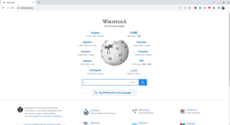
Back Wêreldwye web Afrikaans World Wide Web ALS World Wide Web AN Woruldwīd Webb ANG الشبكة العنكبوتية العالمية Arabic ويب ARY ويب ARZ ৱৰ্ল্ড ৱাইড ৱেব Assamese World Wide Web AST Ümumdünya hörümçək toru Azerbaijani
 The historic World Wide Web logo, designed by Robert Cailliau. Currently, there is no widely accepted logo in use for the WWW. | |
| Abbreviation | WWW |
|---|---|
| Year started | 1989 by Tim Berners-Lee |
| Organization | CERN |

The World Wide Web (WWW or simply the Web) is an information system that enables content sharing over the Internet through user-friendly ways meant to appeal to users beyond IT specialists and hobbyists.[1] It allows documents and other web resources to be accessed over the Internet according to specific rules of the Hypertext Transfer Protocol (HTTP).[2]
The Web was invented by English computer scientist Tim Berners-Lee while at CERN in 1989 and opened to the public in 1991. It was conceived as a "universal linked information system".[3][4] Documents and other media content are made available to the network through web servers and can be accessed by programs such as web browsers. Servers and resources on the World Wide Web are identified and located through character strings called uniform resource locators (URLs).
The original and still very common document type is a web page formatted in Hypertext Markup Language (HTML). This markup language supports plain text, images, embedded video and audio contents, and scripts (short programs) that implement complex user interaction. The HTML language also supports hyperlinks (embedded URLs) which provide immediate access to other web resources. Web navigation, or web surfing, is the common practice of following such hyperlinks across multiple websites. Web applications are web pages that function as application software. The information in the Web is transferred across the Internet using HTTP. Multiple web resources with a common theme and usually a common domain name make up a website. A single web server may provide multiple websites, while some websites, especially the most popular ones, may be provided by multiple servers. Website content is provided by a myriad of companies, organizations, government agencies, and individual users; and comprises an enormous amount of educational, entertainment, commercial, and government information.
The Web has become the world's dominant information systems platform.[5][6][7][8] It is the primary tool that billions of people worldwide use to interact with the Internet.[2]
- ^ Wright, Edmund, ed. (2006). The Desk Encyclopedia of World History. New York: Oxford University Press. p. 312. ISBN 978-0-7394-7809-7.
- ^ a b "What is the difference between the Web and the Internet?". W3C Help and FAQ. W3C. 2009. Archived from the original on 9 July 2015. Retrieved 16 July 2015.
- ^ Berners-Lee, Tim. "Information Management: A Proposal". w3.org. The World Wide Web Consortium. Archived from the original on 1 April 2010. Retrieved 12 February 2022.
- ^ "The World's First Web Site". HISTORY. 30 August 2018. Archived from the original on 19 August 2023. Retrieved 19 August 2023.
- ^ Bleigh, Michael (16 May 2014). "The Once And Future Web Platform". TechCrunch. Archived from the original on 5 December 2021. Retrieved 9 March 2022.
- ^ "World Wide Web Timeline". Pews Research Center. 11 March 2014. Archived from the original on 29 July 2015. Retrieved 1 August 2015.
- ^ Dewey, Caitlin (12 March 2014). "36 Ways The Web Has Changed Us". The Washington Post. Archived from the original on 9 September 2015. Retrieved 1 August 2015.
- ^ Cite error: The named reference
internetlivestatswas invoked but never defined (see the help page).